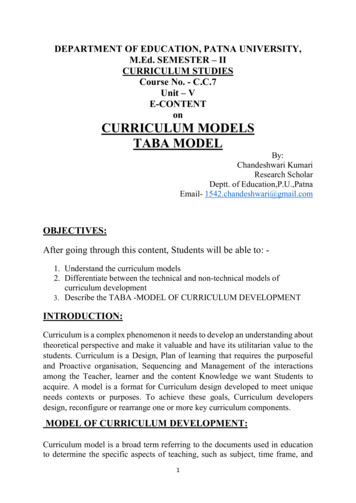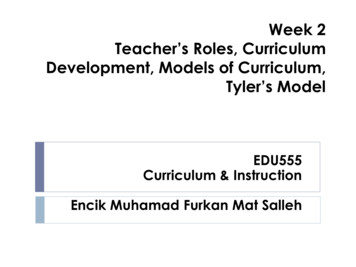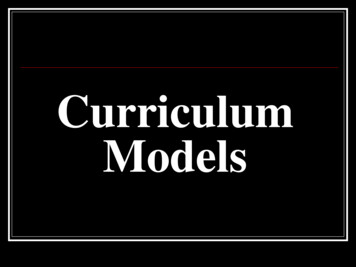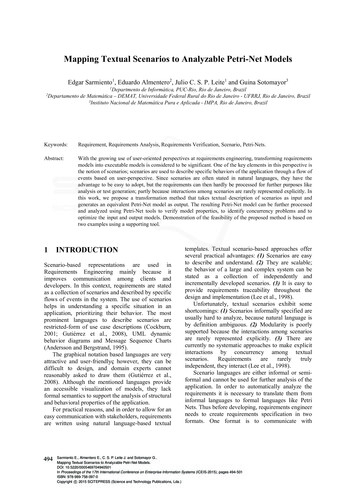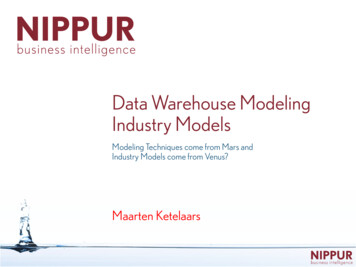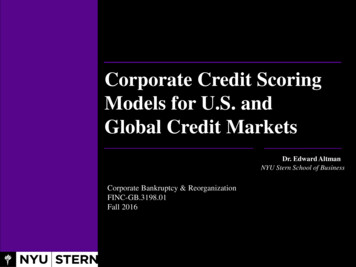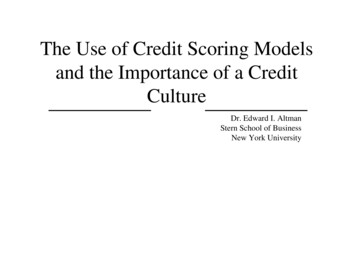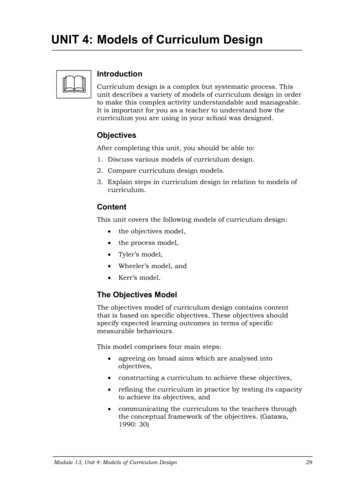
Transcription
UNIT 4: Models of Curriculum DesignIntroductionCurriculum design is a complex but systematic process. Thisunit describes a variety of models of curriculum design in orderto make this complex activity understandable and manageable.It is important for you as a teacher to understand how thecurriculum you are using in your school was designed.ObjectivesAfter completing this unit, you should be able to:1. Discuss various models of curriculum design.2. Compare curriculum design models.3. Explain steps in curriculum design in relation to models ofcurriculum.ContentThis unit covers the following models of curriculum design: the objectives model, the process model, Tyler’s model, Wheeler’s model, and Kerr’s model.The Objectives ModelThe objectives model of curriculum design contains contentthat is based on specific objectives. These objectives shouldspecify expected learning outcomes in terms of specificmeasurable behaviours.This model comprises four main steps: agreeing on broad aims which are analysed intoobjectives, constructing a curriculum to achieve these objectives, refining the curriculum in practice by testing its capacityto achieve its objectives, and communicating the curriculum to the teachers throughthe conceptual framework of the objectives. (Gatawa,1990: 30)Module 13, Unit 4: Models of Curriculum Design29
Objectives Model1. Curriculum Idea2. Objectives4. Evaluation3. ContentMaterialMethodologyAdapted from Gatawa, B. S. M. (1990: 28). The Politics of theSchool Curriculum: An Introduction. Harare: Jongwe Press.You will note that in this model: Evaluation is done at each stage of the curriculumdesign. Content, materials and methodology are derived from theobjectives.The Process ModelUnlike the objectives model, this model does not considerobjectives to be important. Using this model presupposes that: Content has its own value. Therefore, it should not beselected on the basis of the achievement of objectives. Content involves procedures, concepts and criteria thatcan be used to appraise the curriculum. Translating content into objectives may result inknowledge being distorted. Learning activities have their own value and can bemeasured in terms of their own standard. For thisreason, learning activities can stand on their own.(Gatawa, 1990: 31)Module 13, Unit 4: Models of Curriculum Design30
Process ModelCurriculum pted from Gatawa, B. S. M. (1990: 31). The Politics of theSchool Curriculum: An Introduction. Harare: Jongwe Press.It is important to note that in the process model: Content and methodology are derived from the goals.Each of them has outcomes that can be evaluated. The evaluation results from the outcome are fed into thegoals, which will later influence the content andmethodologies. Unlike the objectives model, there is nodirect evaluation of the content and methodologies.Self-Assessment 1What is the difference between the objectives model and theprocess model of curriculum design?Possible answers to this activity are provided at the end of thisunit.The process and objectives models of curriculum design are notthe only models. The remaining part of the unit will covermodels developed by Tyler, Wheeler and Kerr.Tyler’s ModelTyler’s model for curriculum designing is based on the followingquestions: What educational purposes should the school seek toattain?Module 13, Unit 4: Models of Curriculum Design31
What educational experiences can be provided that arelikely to attain these purposes? How can these educational experiences be effectivelyorganised? How can we determine whether these purposes are beingattained?Tyler’s ModelObjectivesSelection of learning experiencesOrganisation of learning experiencesEvaluationAdapted from Urevbu, A. O. (1985: 20). Curriculum Studies.The model is linear in nature, starting from objectives andending with evaluation. In this model, evaluation is terminal. Itis important to note that: Objectives form the basis for the selection andorganisation of learning experiences. Objectives form the basis for assessing the curriculum. Objectives are derived from the learner, contemporarylife and subject specialist.To Tyler, evaluation is a process by which one matches theinitial expectation with the outcomes.Wheeler’s ModelWheeler’s model for curriculum design is an improvement uponTyler’s model. Instead of a linear model, Wheeler developed acyclical model. Evaluation in Wheeler’s model is not terminal.Findings from the evaluation are fed back into the objectivesand the goals, which influence other stages.Module 13, Unit 4: Models of Curriculum Design32
Wheeler’s Model1Aims, goalsandobjectives2Selection oflearningexperiences5Evaluation4Organisation andintegration ofexperiences3Selectionof contentAdapted from Urevbu, A. O. (1985: 22). Curriculum Studies.Wheeler contends that: Aims should be discussed as behaviours referring to theend product of learning which yields the ultimate goals.One can think of these ultimate goals as outcomes. Aims are formulated from the general to the specific incurriculum planning. This results in the formulation ofobjectives at both an enabling and a terminal level. Content is distinguished from the learning experienceswhich determine that content.Self-Assessment 2Define a terminal objective and an enabling objective.Possible answers to this activity are provided at the end of thisunit.Kerr’s ModelMost of the features in Kerr’s model resemble those inWheeler’s and Tyler’s models. However, Kerr divided thedomains into four areas (Urevbu, 1985: 23):Module 13, Unit 4: Models of Curriculum Design33
objectives, knowledge, evaluation, and school learning experiences.A simplified version of Kerr’s model of curriculum design isshown below.1. Objectives2. Knowledge3. Evaluation4. School learningexperiencesWhat you should note about the model is that: the four domains are interrelated directly or indirectly,and objectives are derived from school learning experiencesand knowledge.In Kerr’s model, objectives are divided into three groups: affective cognitive psychomotor.The model further indicates that knowledge should be (Urevbu,1985): organised, integrated, sequenced, and reinforced.Evaluation in Kerr’s model is the collection of information foruse in making decisions about the curriculum.School learning experiences are influenced by societalopportunities, the school community, pupil and teacherModule 13, Unit 4: Models of Curriculum Design34
relationships, individual differences, teaching methods, contentand the maturity of the learners. These experiences areevaluated through tests, interviews, assessments and otherreasonable methods.In his model, Kerr asserts that everything influences everythingelse and that it is possible to start an analysis at any point(Urevbu, 1985: 22).Self-Assessment 3In Kerr’s model, what do you think are the important pointsraised about objectives?Possible answers to this question are provided at the end ofthis unit.There are many curriculum design models. The modelsdiscussed in this unit are meant to give you an idea of howthey are used to develop a curriculum.In designing a curriculum, you need to: Establish or obtain general goals of education. Reduce the general goals to specific instructionalobjectives, including objectives that cover differentdomains and levels. Assess prior student knowledge and/or abilities. Break learning into small, sequential steps. Identify teacher behaviour. Identify student behaviour. Write a description of the lesson. Evaluate to see if the intended outcomes have beenachieved.If you complete these eight stages, you would have conductedwhat is generally referred to as the task analysis process.SummaryThe curriculum design models discussed show that curriculumdesigning is conducted stage by stage. Some of the modelsdiscussed consider the process to be more important than theobjectives. Other models take objectives to be the mostimportant feature of curriculum design. Generally, all modelsstress the importance of considering a variety of factors thatinfluence curriculum.Now that you have read about the types of curriculum design,factors that influence curriculum design and models used toModule 13, Unit 4: Models of Curriculum Design35
design the curriculum, the next unit discusses the personneland departments involved in the curriculum design process. ?ReflectionAs a practising teacher, on which model or models ofcurriculum design do you think your national schoolcurriculum was based? How does the model affect what youactually teach in class?Unit TestList the stages in the task analysis process that you need tofollow when designing a curriculum.Possible answers to this test are provided at the end of thisunit.Module 13, Unit 4: Models of Curriculum Design36
Suggested AnswersSelf-Assessment 1The differences between the objectives and process models areoutlined below. The objectives model derives content and methodologyfrom objectives, whereas the process model derivescontent and methodology from curriculum aim. The evaluation results in the objectives model improveand influence all stages, including the curriculum idea,objectives, content, material and methodology. In theprocess model, the evaluation is conducted on theoutcomes and influences curriculum goals.Self-Assessment 2Below are possible definitions for terminal and enablingobjectives.Terminal objective: Statement of what the learner should beable to achieve at the conclusion of a unitof instruction.Enabling objective: The sub-objectives of a terminal objectivewhich will make it possible for a learner toarrive at the terminal behaviour.Self-Assessment 3In Kerr’s model, objectives: are based on learning experiences and knowledge,societal needs and the requirements of the disciplines; are divided into cognitive, psychomotor and effectivedomains; and give the standard on which evaluation is based.Unit TestYour answer may take the form below.The eight stages which one has to go through in a task analysisprocess are: Establish or obtain general goals of education. Reduce the general goals to specific instructionalobjectives, including objectives for different domains andlevels.Module 13, Unit 4: Models of Curriculum Design37
Assess prior student knowledge and/or abilities. Break learning into small, sequential steps. Identify teacher behaviour. Identify student behaviour. Write a description of the lesson to be delivered. Evaluate to determine if the intended outcomes havebeen achieved.Module 13, Unit 4: Models of Curriculum Design38
A simplified version of Kerr’s model of curriculum design is shown below. What you should note about the model is that: the four domains are interrelated directly or indirectly, and objectives are derived from school learning experiences and knowledge. In Kerr’s model, objectives are divided into three groups: affective cognitive psychomotor. The model further indicates

